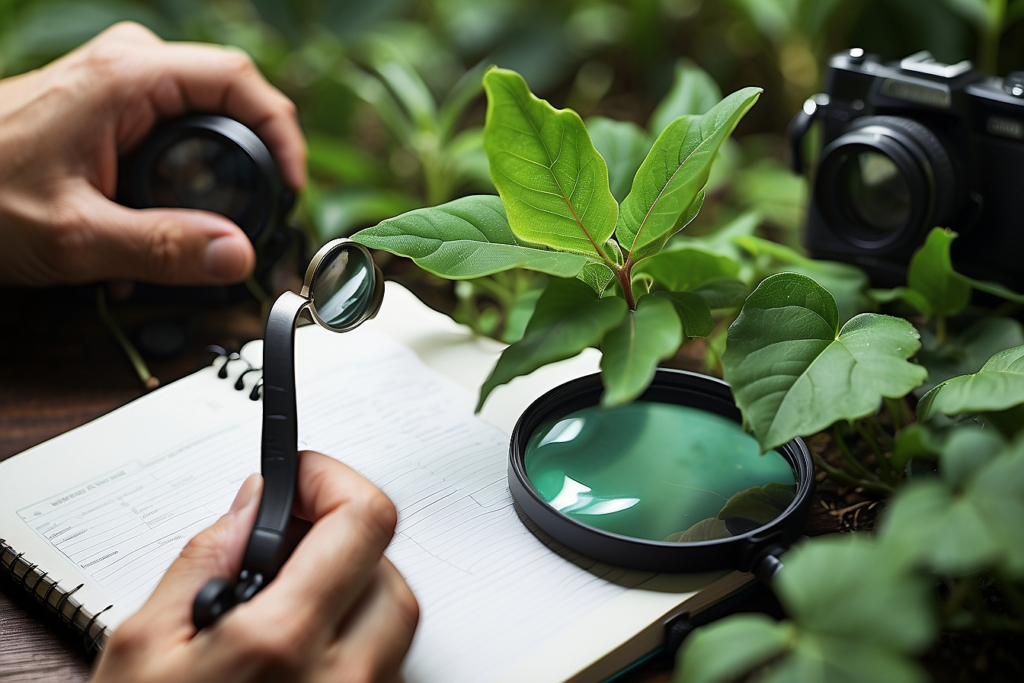Picture this: You’ve lovingly tended your garden for weeks, eagerly anticipating lush greenery and vibrant blooms. But instead of a thriving oasis, you’re faced with wilting leaves, spotted foliage, and plants that seem to be throwing in the towel. Don’t panic! Every gardener, from novice to expert, faces plant problems at some point. The good news? We can solve most issues without resorting to harsh chemicals that harm our environment. Let’s embark on a green detective mission to uncover what’s ailing your plants and how to nurse them back to health, naturally!
The Plant Detective’s Toolkit
Before we dive into specific problems, let’s assemble our eco-friendly detective kit:
1. A magnifying glass: For spotting tiny pests or early signs of disease
2. A notebook: To record symptoms and track progress
3. A camera: To document issues and compare over time
4. Your senses: Sight, touch, and smell can reveal a lot about plant health
Remember, the key to solving plant mysteries is observation and patience. Now, let’s investigate some common plant problems and their earth-friendly solutions!

Mystery 1: The Case of the Wilting Wonders
Symptom: Your plants are drooping, despite your best efforts.
Possible Culprits:
1. Underwatering: The most common cause of wilting.
2. Overwatering: Yes, too much love can be a bad thing!
3. Root damage: Often caused by overwatering or poor drainage.
Eco-Friendly Solutions:
– Check soil moisture: Stick your finger about an inch into the soil. If it’s dry, water deeply. If it’s soggy, hold off on watering.
– Improve drainage: Add organic matter to heavy soils or consider raised beds.
– Water wisely: Water deeply but less frequently to encourage deep root growth.
Mystery 2: The Puzzle of the Spotted Leaves
Symptom: Your plant leaves are developing spots or discoloration.
Possible Culprits:
1. Fungal diseases: Often caused by wet leaves or poor air circulation.
2. Nutrient deficiencies: Each nutrient shortage has its own signature look.
3. Sunburn: Yes, plants can get sunburned too!
Eco-Friendly Solutions:
– Improve air circulation: Prune crowded plants and avoid wetting leaves when watering.
– Feed naturally: Use compost or organic fertilizers to address nutrient imbalances.
– Provide shade: Use shade cloth for sensitive plants during the hottest part of the day.
Mystery #3: The Riddle of the Holey Leaves
Symptom: Something’s been munching on your plant leaves!
Possible Culprits:
1. Caterpillars: They can chew large holes in leaves overnight.
2. Slugs and snails: Look for slime trails as evidence.
3. Beetles: Many types enjoy a leafy meal.
Eco-Friendly Solutions:
– Handpick pests: For larger insects, simply remove them by hand (wear gloves!).
– Set up barriers: Use copper tape or diatomaceous earth to deter slugs and snails.
– Invite beneficial insects: Plant flowers that attract ladybugs, lacewings, and other pest predators.

Mystery 4: The Secret of the Stunted Growth
Symptom: Your plants aren’t growing as they should.
Possible Culprits:
1. Compacted soil: Roots can’t breathe or spread easily.
2. Improper pH: Plants can’t absorb nutrients if the soil pH is off.
3. Lack of sunlight: Most plants need adequate light to thrive.
Eco-Friendly Solutions:
– Aerate the soil: Use a garden fork to gently loosen compacted soil.
– Test and adjust pH: Use organic materials like sulfur to lower pH or lime to raise it.
– Reassess plant placement: Move plants to areas with appropriate light levels.
Mystery 5: The Conundrum of the Yellowing Leaves
Symptom: Your plant’s leaves are turning yellow.
Possible Culprits:
1. Nutrient deficiency: Often nitrogen, but could be iron or magnesium.
2. Overwatering: Waterlogged roots can’t deliver nutrients effectively.
3. Pest infestation: Some sap-sucking insects can cause yellowing.
Eco-Friendly Solutions:
– Feed with compost: A good, balanced compost can address most nutrient needs.
– Adjust watering: Ensure proper drainage and water only when the top inch of soil is dry.
– Introduce beneficial insects: Ladybugs and lacewings can help control sap-sucking pests.
General Tips for Happy, Healthy Plants
1. Right plant, right place: Choose plants suited to your climate and garden conditions.
2. Build healthy soil: Compost, compost, compost! It’s the foundation of plant health.
3. Practice crop rotation: It helps prevent pest and disease buildup in the soil.
4. Mulch: It conserves moisture, suppresses weeds, and regulates soil temperature.
5. Observe regularly: Catch problems early by checking your plants often.
Remember, every plant problem is an opportunity to learn and grow as a gardener. By choosing eco-friendly solutions, you’re not just solving the immediate issue – you’re contributing to a healthier garden ecosystem and a cleaner planet.
As you become more attuned to your plants’ needs, you’ll find yourself developing a sixth sense for plant health. You’ll notice subtle changes before they become big problems, and you’ll feel more connected to the natural rhythms of your garden.
So the next time you spot a drooping leaf or a mysterious spot, don’t reach for the chemical spray. Take a deep breath, grab your eco-friendly detective kit, and start investigating. Your plants – and the planet – will thank you for your natural approach to problem-solving.
Happy gardening, and may all your plant mysteries have green, thriving solutions!


















